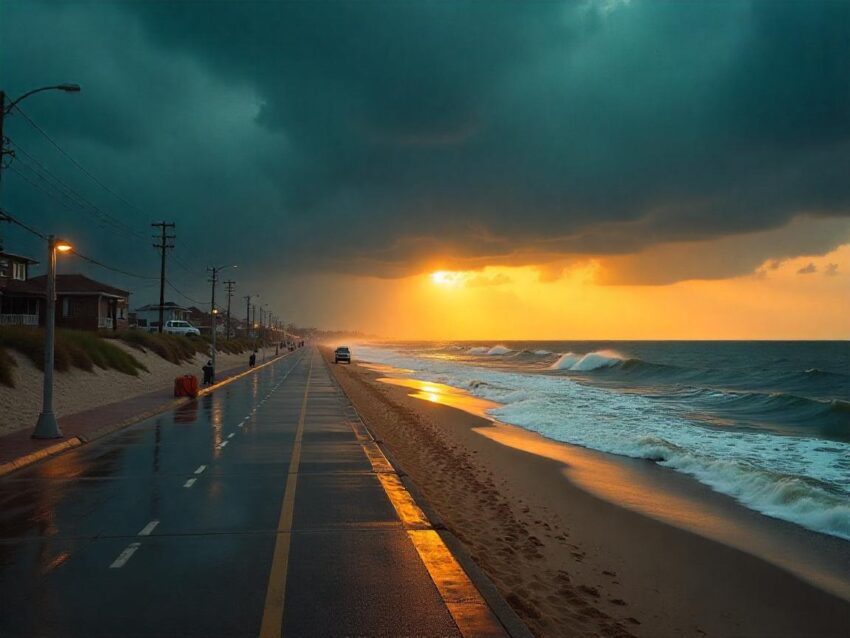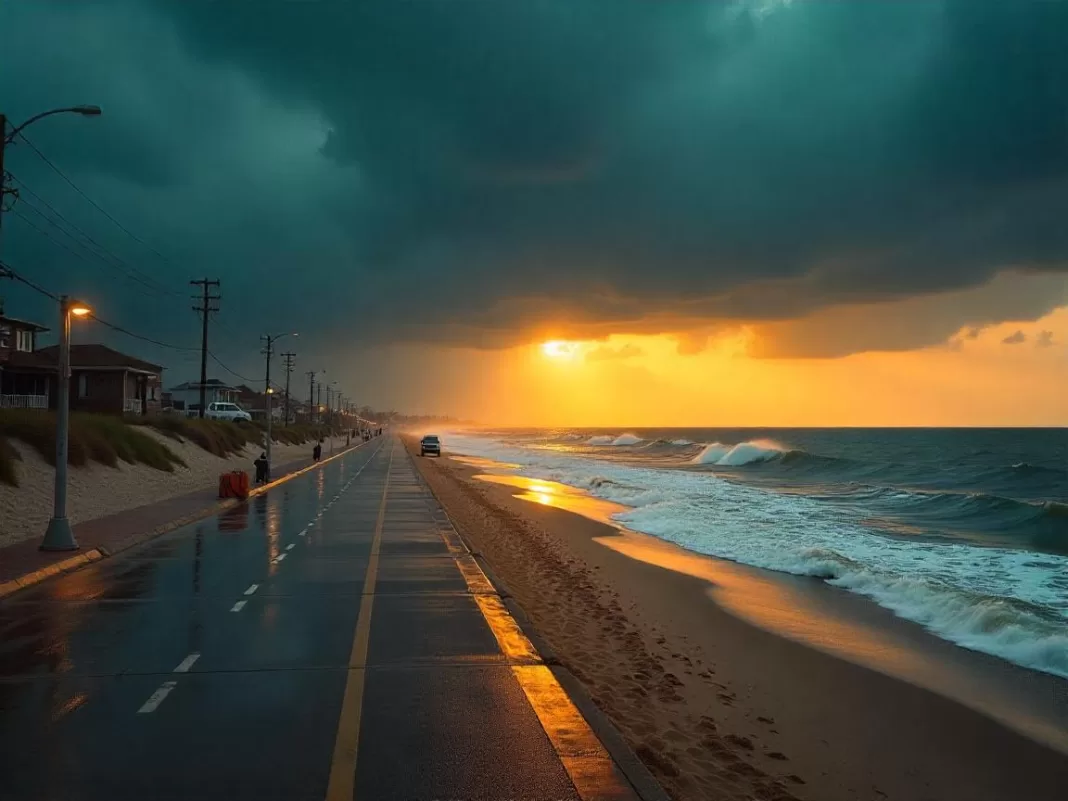Thursday, May 22, 2025

A rare May nor’easter storm is set to batter the Northeast US, and just in time to disrupt summer travel plans ahead of the much-anticipated Memorial Day weekend surge. But here’s the twist—this might just surprise you. Instead of sunshine, a wall of wind and rain is moving in fast. Travel chaos is on the horizon. Flights may be grounded. Coastal towns could go quiet. And summer’s grand kickoff? It’s at serious risk. The timing is eerie. The impact could be massive. Keep reading—this isn’t just another storm. It’s a game-changer for Memorial Day in the Northeast US. Get ready for a rare May nor’easter—and not the kind anyone expected this late in the season. This storm isn’t just passing through. It’s gearing up to batter the Northeast US with heavy rain, chilling winds, and total chaos. And just when you thought summer was around the corner, this surprise twist may completely disrupt travel plans that have been months in the making.
Yes, you read that right. A rare May nor’easter storm is taking aim at the Northeast US. And the timing couldn’t be worse. It’s landing ahead of Memorial Day weekend, one of the biggest surges in summer travel each year. What’s even more shocking? The intensity. The timing. The chill. Everything about it screams unseasonal, unpredictable, and frankly, unbelievable.
Memorial Day weekend usually marks the start of sunshine, sandals, and seaside getaways. But not this year. Not in the Northeast US. This rare storm is rewriting the rules—and it’s already causing turbulence for tourists, airlines, and local economies.
Imagine planning your big summer travel escape—bags packed, tickets in hand—only to be hit by pounding rain and wind. Flights? Delayed. Roads? Flooded. Beaches? Empty. Hotels? Getting cancellations by the hour. This is no ordinary spring drizzle. This is a rare May nor’easter storm coming in fast and strong, just days before the Memorial Day travel surge hits full throttle.
And here’s where it gets really wild—these kinds of storms almost never happen in May. The clash of cold Arctic air and warmer Atlantic breezes has created the perfect storm—literally. It’s the kind of setup meteorologists usually see in March or April. So why is it happening now? And what does it mean for your weekend?
This isn’t just about rain. It’s about a sudden, sharp change in the Northeast US travel landscape. A storm like this, at this time, has the power to disrupt summer travel plans on a massive scale. It’s an atmospheric curveball. And yes—this might just surprise you.
There’s more. Much more. This story is unfolding fast—and the ripple effects could stretch far beyond the Northeast. From airlines scrambling to adjust schedules to hotels bracing for cancellations, the entire Memorial Day weekend surge could be in jeopardy.
So buckle up. Because this rare May nor’easter storm isn’t done yet.
Memorial Day weekend and summer travel usually signals the joyful kick-off to summer vacations in the U.S. But this year, the East Coast faces a jarring twist. A rare May nor’easter is on track to drench travel plans, disrupt flights, and put a damper on hotel bookings across one of the busiest holiday weekends in the American tourism calendar.
Instead of sun and sand, travelers can expect sheets of rain, gusty winds, and cold, March-like temperatures. And the timing couldn’t be worse for an already-sensitive tourism and airline sector banking on Memorial Day to bounce back from spring lulls.
Unseasonable Chill Arrives as Tourists Pack Bags
This unusual coastal storm will be the result of an atmospheric battle between unseasonable Arctic cold pushed southward and lingering Atlantic warmth. As a result, the Northeast and mid-Atlantic are bracing for a wintry cocktail of soaking rains, blustery winds, and rough seas that feel completely out of place in late May.
Cities like New York, Boston, and Philadelphia—all major gateways for domestic and international travelers—are in the storm’s crosshairs. Airlines, already stretched with high seasonal demand, may now see cascading delays, missed connections, and stranded passengers as the nor’easter builds.
Tourists planning coastal getaways or scenic drives through New England are likely to face canceled excursions, washed-out trails, and storm-churned coastlines. Local economies that depend heavily on Memorial Day footfall could see steep drops in revenue.
Airline and Airport Disruptions Likely to Ripple Nationally
The storm is not just a meteorological anomaly—it’s a logistical nightmare. With rain totals approaching 2–3 inches in parts of New Jersey, New York, and southern New England, airports like JFK, LaGuardia, and Boston Logan may see widespread operational delays. Gusty winds could ground smaller aircraft and delay larger ones, triggering a domino effect across hubs nationwide.
This could not come at a worse time for air travel.
Memorial Day weekend typically ranks as one of the top five busiest travel periods in the U.S. Airlines are already struggling with pilot shortages, overbooked flights, and tight turnaround windows. Adding a potent coastal storm into the mix raises the threat of chaos both on the ground and in the skies.
Travelers could find themselves spending more time in terminals than on beaches. That spells trouble for brand trust and future bookings. Industry stakeholders may face an avalanche of rebooking requests, refund demands, and strained customer service lines.
Hotel Stays and Local Tourism Take a Hit
Hospitality players along the East Coast—from boutique B&Bs in Cape Cod to high-rise hotels in Atlantic City—have been prepping for this crucial weekend for months. Memorial Day not only kicks off summer tourism but also sets the tone for seasonal earnings.
Now, last-minute cancellations are climbing. Calls to delay or cut trips short are flooding hotel front desks. Meanwhile, restaurants, outdoor tours, amusement parks, and beach towns stand to lose hundreds of thousands in tourism revenue if footfall drops sharply.
A gloomy, wind-whipped weekend will leave many travelers opting to stay home rather than face the stormy uncertainty. Worse still, those who do make the trip may share negative reviews that shape the summer season’s outlook.
Chilling Reminder of Climate Impact on Travel
This rare May nor’easter isn’t just a weather fluke—it’s a flashing red light in the climate change conversation.
Arctic regions have been experiencing record-high May temperatures, particularly in Greenland, Iceland, and parts of Canada. This heat is displacing colder air masses and funneling them farther south than usual—setting the stage for a storm like this.
The pattern resembles those more typical of late winter, not the edge of summer. Climate-driven weather volatility is becoming a significant challenge for the travel industry. From hurricanes to heatwaves and now rare spring nor’easters, trip planners must brace for increasing unpredictability.
The Forecast: Damp Now, Better Later
The storm’s first wave has already brought gloomy skies and rain to the mid-Atlantic. The main nor’easter system will rev up overnight Thursday, sliding along the coast and intensifying as it approaches New England through the weekend.
Rainfall amounts could exceed 3 inches in some areas, especially southern New England. Flash flooding is unlikely, but localized flooding in vulnerable urban spots could disrupt road travel.
Winds will pick up from Thursday into Saturday. Saturated soils and gusty conditions raise the risk of fallen trees and downed power lines. These could snarl traffic or knock out power to local tourist hotspots, further complicating weekend plans.
Fortunately, there’s a silver lining. The worst of the storm should begin easing by Sunday. While some dampness may linger, temperatures are expected to rebound. Sunshine and seasonal warmth will likely return just in time for Memorial Day Monday—offering a brief window for salvaging barbecues, beach outings, and final day travel.
Strategic Implications for the Travel Industry
Airlines, hoteliers, and local tourism boards must react swiftly. Proactive communications, flexible booking policies, and real-time updates will be key to maintaining traveler trust.
Moreover, this event highlights the importance of climate-aware infrastructure and forecasting tools. Travel industry leaders may need to rethink operational calendars, insurance coverage, and event scheduling around an increasingly volatile spring climate.
Meanwhile, destination marketing groups must be nimble—pivoting to promote indoor attractions, storm-season experiences, or late summer packages in response to early season weather flops.
If this nor’easter teaches anything, it’s that adaptability is now the price of resilience in the travel world.
Source: CNN






